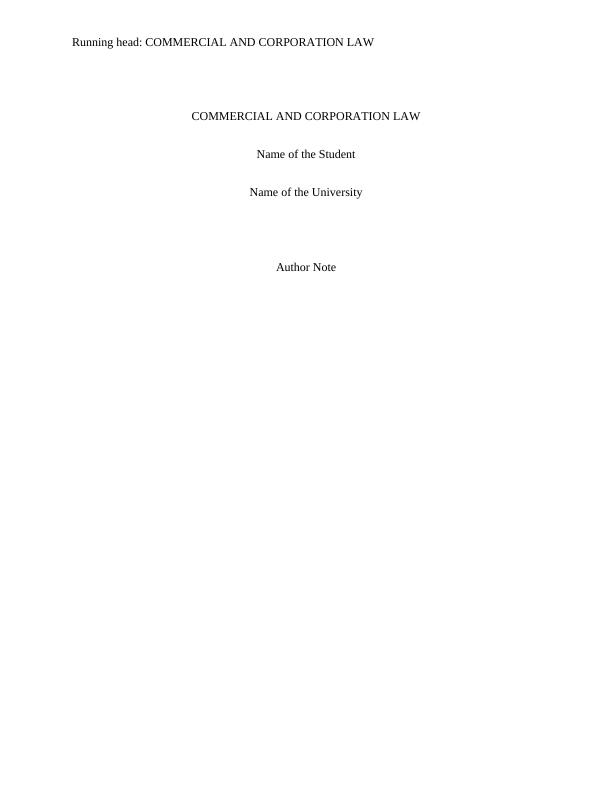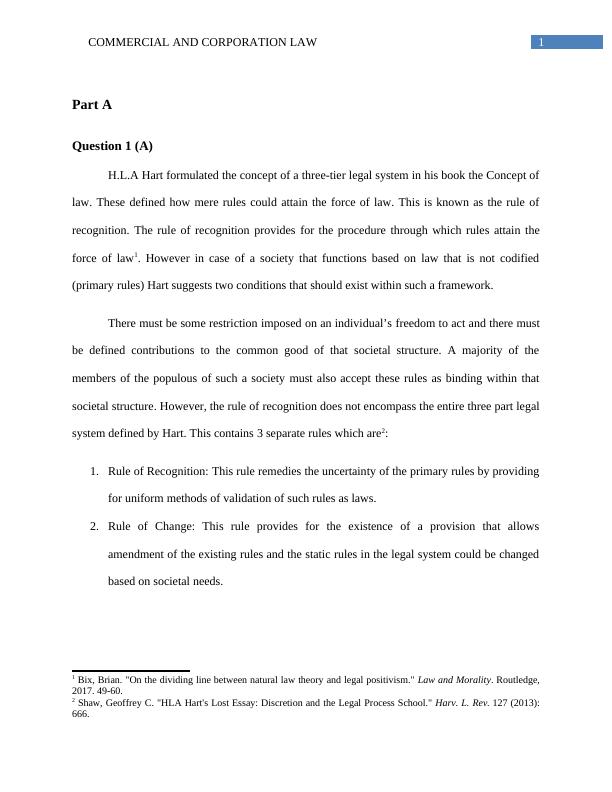Corporate and Commercial Law : Assignment
12 Pages2687 Words24 Views
Added on 2021-06-15
Corporate and Commercial Law : Assignment
Added on 2021-06-15
ShareRelated Documents
Running head: COMMERCIAL AND CORPORATION LAWCOMMERCIAL AND CORPORATION LAWName of the StudentName of the UniversityAuthor Note

1COMMERCIAL AND CORPORATION LAWPart AQuestion 1 (A)H.L.A Hart formulated the concept of a three-tier legal system in his book the Concept oflaw. These defined how mere rules could attain the force of law. This is known as the rule ofrecognition. The rule of recognition provides for the procedure through which rules attain theforce of law1. However in case of a society that functions based on law that is not codified(primary rules) Hart suggests two conditions that should exist within such a framework.There must be some restriction imposed on an individual’s freedom to act and there mustbe defined contributions to the common good of that societal structure. A majority of themembers of the populous of such a society must also accept these rules as binding within thatsocietal structure. However, the rule of recognition does not encompass the entire three part legalsystem defined by Hart. This contains 3 separate rules which are2:1.Rule of Recognition: This rule remedies the uncertainty of the primary rules by providingfor uniform methods of validation of such rules as laws.2.Rule of Change: This rule provides for the existence of a provision that allowsamendment of the existing rules and the static rules in the legal system could be changedbased on societal needs.1 Bix, Brian. "On the dividing line between natural law theory and legal positivism."Law and Morality. Routledge,2017. 49-60.2 Shaw, Geoffrey C. "HLA Hart's Lost Essay: Discretion and the Legal Process School."Harv. L. Rev.127 (2013):666.

2COMMERCIAL AND CORPORATION LAW3.Rule of Adjudication: This provides for a mode of certain adjudication (such as theformation of a judiciary) this rule would define who determines and adjudicates issues incase there is an allegation that rules have been broken.Thus, for a tribe that follows primary rules such a system needs to be implemented toensure that there is uniformity in adjudication and the concept of justice. Thus in such a case thetribe would first to enact a constitution which defines the system of governance and separates thepowers and responsibilities of all the various wings3. This constitution would thus have toembody all the three rules recommended by Hart and does so by:1.Providing a rule for validity: For the uniformity in traditions of the tribe customs that areaccepted by the tribe would have to be considered as the primary rules prevailing in thatsocietal structure. This provision would also provide for why these customs are acceptedas laws and in such a case any other practices that meet the parameters of such a rule ofrecognition would also be considered a law under the constitution. This provision wouldembody the first rule of Hart’s recommended legal system. This provision would alsostate that the earlier decisions in the same circumstances would have to be consideredwhen deciding present disputes.2.Providing a rule for amendment: This would also be provided for in the constitution andit would state that the customs and practices accepted as rules as per the prevailing legalsystem would be binding on all circumstances falling within the ambit of such arecognized rule. However, this provision would state that in case it can be successfullyestablished that the societal framework requires an amendment to the existing customsuch a custom would be liable to be amended to the extent required for operation of3 Priel, Dan. "Reconstructing Fuller’s Argument against Legal Positivism."Canadian Journal of Law &Jurisprudence26.2 (2013): 399-413.

3COMMERCIAL AND CORPORATION LAWuniformity. Thus, it would mean that these laws are binding but are not absolute when thesocietal framework requires a change. This would thus embody the rule of changerecommended by Hart.3.Providing the rule of adjudication: This provision of the constitution would provide forthe separation of powers. It would recommend the formation of a judicial body comprisedof elders, but these elders should ideally be different from the ones who decide whichcustoms are to be accepted as laws of the tribe (thus causing a separation of powersbetween legislature and judiciary). These elders would be tasked with adjudication ofdisputes. However, in such a system there must be representation of the subsequentgenerations and thus the judicial system of elders should also comprise of representationfrom the younger generations (in proportion to the number of elders to ensure there is abalance in the adjudication process). During the adjudication process the judicial bodywould have to consider previous decisions but the effect of these decisions would besubject to the rule of change. This would thus embody Hart’s third recommendation ofthe rule of adjudication.Australia embodies Hart’s recommended legal system as well. It has a constitution (theCommonwealth of Australia Constitution Act) which recognizes law and provides foramendment in case it is required thus embodying the rule of recognition and the rule of change4.The constitution also provides for a clear separation of powers by dividing the government intothree wings the legislature (to enact the laws) an executive (to enforce the laws) and a judiciary(to interpret the laws). Thus the judicial wing of the government is tasked with adjudicating legal4 Croce, Mariano. "A Practice Theory of Legal Pluralism: Hart’s (inadvertent) defence of the indistinctiveness oflaw."Canadian Journal of Law & Jurisprudence27.1 (2014): 27-47.

End of preview
Want to access all the pages? Upload your documents or become a member.
Related Documents
Commercial Law: Rules and Principles for Lease, Misrepresentation, and Restrictive Covenantlg...
|12
|3224
|318
Australian Commercial Law - Doclg...
|11
|2452
|50
Australian Commercial Law, Criminal Justice System, Lease Agreement, Misrepresentation in Blogging, Contract Lawlg...
|11
|3057
|247
Assignment on Australian Commercial Law pdflg...
|14
|3481
|42
Australian commercial Law Assignment (PDF)lg...
|10
|2510
|32
Australian commercial Law PDFlg...
|13
|3287
|48
